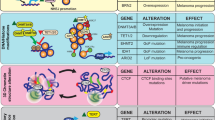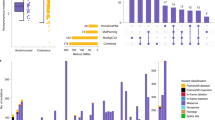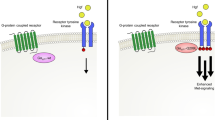Abstract
Multiple genetic alterations occur in melanoma, a lethal skin malignancy of increasing incidence1,2. These include mutations that activate Ras and two of its effector cascades, Raf and phosphoinositide 3-kinase (PI3K). Induction of Ras and Raf can be caused by active N-Ras and B-Raf mutants as well as by gene amplification3,4,5. Activation of PI3K pathway components occurs by PTEN loss and by AKT3 amplification6,7,8. Melanomas also commonly show impairment of the p16INK4A-CDK4-Rb and ARF-HDM2-p53 tumor suppressor pathways. CDKN2A mutations can produce p16INK4A and ARF protein loss5,9,10,11. Rb bypass can also occur through activating CDK4 mutations as well as by CDK4 amplification5,12. In addition to ARF deletion, p53 pathway disruption can result from dominant negative TP53 mutations5,13. TERT amplification also occurs in melanoma5. The extent to which these mutations can induce human melanocytic neoplasia is unknown. Here we characterize pathways sufficient to generate human melanocytic neoplasia and show that genetically altered human tissue facilitates functional analysis of mutations observed in human tumors.
This is a preview of subscription content, access via your institution
Access options
Subscribe to this journal
Receive 12 print issues and online access
$209.00 per year
only $17.42 per issue
Buy this article
- Purchase on SpringerLink
- Instant access to full article PDF
Prices may be subject to local taxes which are calculated during checkout




Similar content being viewed by others
References
Gilchrest, B.A., Eller, M.S., Geller, A.C. & Yaar, M. The pathogenesis of melanoma induced by ultraviolet radiation. N. Engl. J. Med. 340, 1341–1348 (1999).
Schaffer, J.V., Rigel, D.S., Kopf, A.W. & Bolognia, J.L. Cutaneous melanoma–past, present, and future. J. Am. Acad. Dermatol. 51, S65–S69 (2004).
Davies, H. et al. Mutations of the BRAF gene in human cancer. Nature 417, 949–954 (2002).
Pollock, P.M. et al. High frequency of BRAF mutations in nevi. Nat. Genet. 33, 19–20 (2003).
Rodolfo, M., Daniotti, M. & Vallacchi, V. Genetic progression of metastatic melanoma. Cancer Lett. 214, 133–147 (2004).
Tsao, H., Goel, V., Wu, H., Yang, G. & Haluska, F.G. Genetic interaction between NRAS and BRAF mutations and PTEN/MMAC1 inactivation in melanoma. J. Invest. Dermatol. 122, 337–341 (2004).
Wu, H., Goel, V. & Haluska, F.G. PTEN signaling pathways in melanoma. Oncogene 22, 3113–3122 (2003).
Stahl, J.M. et al. Deregulated Akt3 activity promotes development of malignant melanoma. Cancer Res. 64, 7002–7010 (2004).
Kamb, A. et al. Analysis of the p16 gene (CDKN2) as a candidate for the chromosome 9p melanoma susceptibility locus. Nat. Genet. 8, 23–26 (1994).
Hussussian, C.J. et al. Germline p16 mutations in familial melanoma. Nat. Genet. 8, 15–21 (1994).
Hayward, N.K. Genetics of melanoma predisposition. Oncogene 22, 3053–3062 (2003).
Wolfel, T. et al. A p16INK4a-insensitive CDK4 mutant targeted by cytolytic T lymphocytes in a human melanoma. Science 269, 1281–1284 (1995).
Albino, A.P. et al. Mutation and expression of the p53 gene in human malignant melanoma. Melanoma Res. 4, 35–45 (1994).
Weitzman, J.B. & Yaniv, M. Rebuilding the road to cancer. Nature 400, 401–402 (1999).
Hamad, N.M. et al. Distinct requirements for Ras oncogenesis in human versus mouse cells. Genes Dev. 16, 2045–2057 (2002).
Nishimura, E.K. et al. Dominant role of the niche in melanocyte stem-cell fate determination. Nature 416, 854–860 (2002).
Sharpless, N.E., Kannan, K., Xu, J., Bosenberg, M.W. & Chin, L. Both products of the mouse Ink4a/Arf locus suppress melanoma formation in vivo. Oncogene 22, 5055–5059 (2003).
Kannan, K. et al. Components of the Rb pathway are critical targets of UV mutagenesis in a murine melanoma model. Proc. Natl. Acad. Sci. USA 100, 1221–1225 (2003).
Beer, S. et al. Developmental context determines latency of MYC-induced tumorigenesis. PLoS Biol. 2, e332 (2004).
Dajee, M. et al. NF-kappaB blockade and oncogenic Ras trigger invasive human epidermal neoplasia. Nature 421, 639–643 (2003).
Lazarov, M. et al. CDK4 coexpression with Ras generates malignant human epidermal tumorigenesis. Nat. Med. 8, 1105–1114 (2002).
Clark, E.A., Golub, T.R., Lander, E.S. & Hynes, R.O. Genomic analysis of metastasis reveals an essential role for RhoC. Nature 406, 532–535 (2000).
Brookes, S., Rowe, J., Gutierrez Del Arroyo, A., Bond, J. & Peters, G. Contribution of p16(INK4a) to replicative senescence of human fibroblasts. Exp. Cell Res. 298, 549–559 (2004).
Randerson-Moor, J.A. et al. A germline deletion of p14(ARF) but not CDKN2A in a melanoma-neural system tumour syndrome family. Hum. Mol. Genet. 10, 55–62 (2001).
Stewart, S.A. et al. Telomerase contributes to tumorigenesis by a telomere length-independent mechanism. Proc. Natl. Acad. Sci. USA 99, 12606–12611 (2002).
Chang, S. & DePinho, R.A. Telomerase extracurricular activities. Proc. Natl. Acad. Sci. USA 99, 12520–12522 (2002).
Kinsella, T.M. & Nolan, G.P. Episomal vectors rapidly and stably produce high-titer recombinant retrovirus. Hum. Gene Ther. 7, 1405–1413 (1996).
Deng, H., Choate, K.A., Lin, Q. & Khavari, P.A. High efficiency gene transfer and pharmacologic selection of genetically engineered human keratinocytes. Biotechniques 25, 274–280 (1998).
Hsu, M., Andl, T., Li, G., Meinkoth, J.L. & Herlyn, M. Cadherin repertoire determines partner-specific gap junctional communication during melanoma progression. J. Cell Sci. 113, 1535–1542 (2000).
Kern, S.E. et al. Oncogenic forms of p53 inhibit p53-regulated gene expression. Science 256, 827–830 (1992).
Acknowledgements
We thank D. Felsher, A. Oro, S. Artandi, H.Y. Chang, S. Swetter, H. Lee, Z. Siprashvili, F. Scholl, J. Reuter, T. Ridky and P. Dumesic for presubmission review and discussions; T. Cai for PI3K reagents; B. Vogelstein and K. Kinzler for p53 reporter constructs; M. Mihm, S. Kohler and J. Harvell for pathologic evaluation; S. Tao for technical support; L. Attardi for PERP antibody; and R. Marais for B-RafV599E and advice. This work was supported by the US Veterans Affairs Office of Research and Development, by the National Institutes of Arthritis and Musculoskeletal and Skin Diseases (US National Institutes of Health). Y.C. is a Howard Hughes Medical Institute predoctoral fellow. A.E.A. was supported by a training grant from the National Institutes of Arthritis and Musculoskeletal and Skin Diseases (US National Institutes of Health) and a Warren-Whitman-Richardson Fellowship.
Author information
Authors and Affiliations
Corresponding author
Ethics declarations
Competing interests
The authors declare no competing financial interests.
Supplementary information
Supplementary Fig. 1
Proliferation and apoptosis of human melanocytes after gene transfer. (PDF 325 kb)
Supplementary Fig. 2
Melanocyte neoplasms are vascularized. (PDF 207 kb)
Supplementary Fig. 3
Confirmation of expression of transferred genes. (PDF 498 kb)
Supplementary Fig. 4
Mosaic marker gene expression in genetically induced melanocytic neoplasms. (PDF 167 kb)
Supplementary Fig. 5
Local invasion but lack of metastasis with A375 human melanoma cell line. (PDF 267 kb)
Supplementary Fig. 6
Immunoblots of p53 targets and Rb. (PDF 151 kb)
Supplementary Fig. 7
Mitotic activity in vivo as a function of hTERT transduction. (PDF 218 kb)
Rights and permissions
About this article
Cite this article
Chudnovsky, Y., Adams, A., Robbins, P. et al. Use of human tissue to assess the oncogenic activity of melanoma-associated mutations. Nat Genet 37, 745–749 (2005). https://doi.org/10.1038/ng1586
Received:
Accepted:
Published:
Issue Date:
DOI: https://doi.org/10.1038/ng1586
This article is cited by
-
RAF inhibitor LY3009120 sensitizes RAS or BRAF mutant cancer to CDK4/6 inhibition by abemaciclib via superior inhibition of phospho-RB and suppression of cyclin D1
Oncogene (2018)
-
IQGAP1 and IQGAP3 Serve Individually Essential Roles in Normal Epidermal Homeostasis and Tumor Progression
Journal of Investigative Dermatology (2015)
-
GAB2 induces tumor angiogenesis in NRAS-driven melanoma
Oncogene (2013)
-
Targeting MAPK pathway in melanoma therapy
Cancer and Metastasis Reviews (2013)



